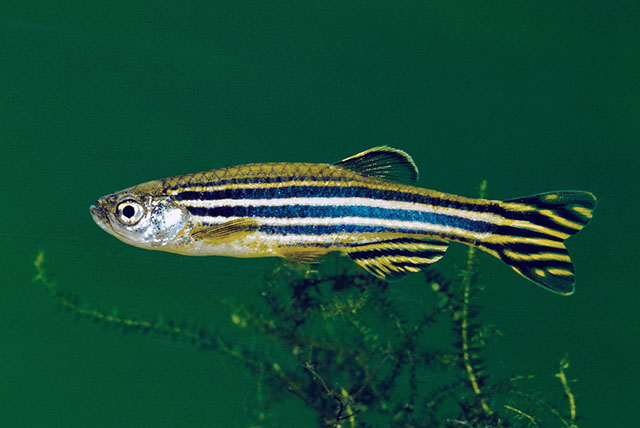| Danionidae (Danios), subfamily: Danioninae |
| 3.8 cm SL (male/unsexed) |
|
benthopelagic; freshwater; pH range: 6 - 8; dH range: 5 - 19 |
| Asia: Pakistan, India, Bangladesh, Nepal and Myanmar (Ref. 41236). Reported from Bhutan (Ref. 40882). Appearance in Colombian waters presumably by escape from an aquarium fish rearing facility (Ref. 1739). |
|
Vertebrae: 31-32. Five uniformly, pigmented, horizontal stripes on the side of the body, all extending onto the end of caudal fin rays. Anal fin distinctively striped. Lateral line absent. Rostral barbels extend to anterior margin of orbit; maxillary barbels end at about middle of opercle. Branched anal fin rays 10-12. Vertebrae 31-32. |
| Adults inhabit streams, canals, ditches, ponds and beels (Ref. 1479). Occur in slow-moving to stagnant standing water bodies, particularly rice-fields (Ref. 4832); and lower reaches of streams (Ref. 58912). Common in rivulets at foot hills (Ref. 41236). Feed on worms and small crustaceans (Ref. 7020); also on insect larvae. Breed all year round (Ref. 58913). Appears to be primarily an annual species in the wild, the spawning season starting just before the onset of the monsoon (Ref. 72224). Domesticated zebrafish live on average 3.5 years, with oldest individuals surviving up to 5.5 years (Ref. 58923). Spawning is induced by temperature and commences at the onset of the monsoon season (Ref. 58913). Food availability also acts as cue for breeding (Ref. 58913). Growth rate is a vital guiding environmental factor for sexual differentiation for this species as observed in a study (Ref. 58948). In this same study, frequency and amount of food prior to and throughout gonadal differentiation period resulted in more individuals differentiating to become females and is more pronounced in hybrid than pure bred groups (Ref. 58948). Often used for mosquito control (Ref 6351). Popular for aquarium purposes (Ref. 44325). Used as a model system (=organism) for developmental biology (Ref. 47810). Aquarium keeping: in groups of 5 or more individuals; minimum aquarium size 60 cm (Ref. 51539). |
|
Least Concern (LC); Date assessed: 09 October 2009 Ref. (130435)
|
| harmless |
Source and more info: www.fishbase.org. For personal, classroom, and other internal use only. Not for publication.
